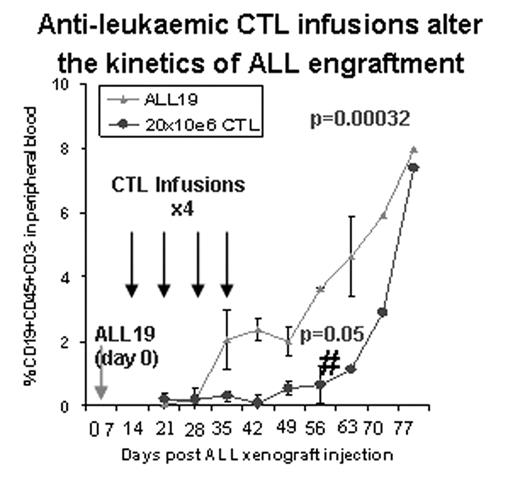Abstract
Acute Lymphocytic Leukaemia (ALL) patients who relapse after transplantation have few therapeutic options. An immunotherapeutic approach that enhances the graft versus leukemia effect may improve their survival. We have developed a method for generating cord blood derived dendritic cells (CBDC) and transfecting them with high efficiency (>90% eGFP positivity) and viability (>90%) (BBMT 2006 12:855–867). We postulate that CTL generated from total ALL RNA-loaded CBDC may be exploited in therapy and therefore tested their ability to control the kinetics of leukaemic growth in a NOD-SCID mouse model of human ALL.
CTL induced using total RNA from the pre-B ALL Nalm-6 cell line lysed 49±11% of Nalm-6 cells compared to 7%±1% of autologous and 2.5%±1.3% of allogeneic mononuclear cells (p=0.03 and p=0.022 respectively). Using total RNA from patient derived ALL xenograft, we generated anti-leukemic CTL cultures comprising a mixed population of 69.9±2% CD4, 12.9±2% CD8 and 17.6±1% NK cells. These CTL lysed 63±6% of ALL xenograft targets and 22±7% of autologous MNC (p=0.04) and also lysed autologous survivin mRNA-transfected DC (16±5.4%). Preliminary results suggest that some of the ALL xenograft CTL also recognize the cell surface protein, HM1.24, which is specifically up-regulated in metastatic tumor cells and chemoresistant cancer cells. This suggests that the total ALL RNA generated CTL comprise a polyclonal population, which may prove efficacious in vivo. To test the in vivo efficacy of these anti-leukemic CTL, we established a NOD-SCID mouse model of ALL using patient samples. By varying the inocula of ALL cells, we established a predictable and reproducible model of emerging relapse.
Administration of anti-leukaemic CTL 2, 3, 4 and 5 weeks post ALL inoculation, in increasing doses (low - 2.5×106 cells/mouse, medium - 10×106/mouse and high - 20×106/mouse), altered the kinetics of ALL growth in vivo (p=0.00032, see figure). By 8 weeks post transplant, mice given ALL alone had 3.6% human CD45+CD19+ leukemic cells in the blood, whereas recipients of the highest CTL dose had only 0.66% CD45+CD19+ leukemic cells in the blood (p=0.05). After 11 weeks the disease load was the same in mice who received ALL alone and those who received ALL and 4 doses of 20 × 106 CTL. These results suggest that anti-leukemic CTL generated by RNA-loaded CBDC can control leukaemia in a NOD-SCID mouse model and that disease control may be enhanced by antigen-specific restimulation of the anti-leukaemic CTL and/or more refined administration. These results represent an important step forward in the development of clinical immunotherapy protocols for the treatment of ALL and its potential application after cord blood transplantation.
Anti-leukaemic CTL infusions alter the kinetics of ALL engraftment
Anti-leukaemic CTL infusions alter the kinetics of ALL engraftment
Disclosure: No relevant conflicts of interest to declare.
Author notes
Corresponding author


This feature is available to Subscribers Only
Sign In or Create an Account Close Modal